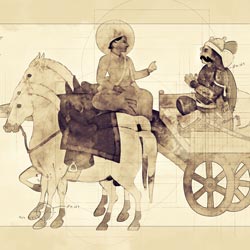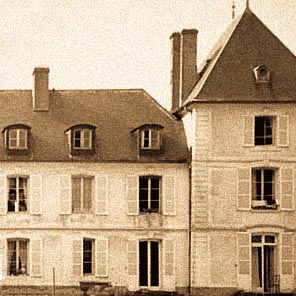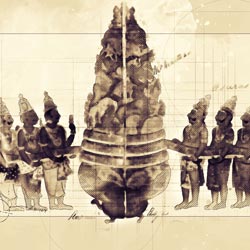
People who share a common aim naturally gravitate towards each other. Gurdjieff groups are formed by people who share a valuation for his teaching and who decide to apply his ideas communally. They can differ in all other respects, as Gurdjieff himself described his own groups in the 1920’s: “Here there are neither Russians nor English, Jews nor Christians, but only those who pursue one aim—to be able to be.” i Sufis gather together to study with a Sheikh, Christian monks with an Abbot, Tibetans with a Lama, and Jews with a Rabbi. Gurdjieff groups are no different in recognizing that group work accelerates individual progress.
One obvious reason for this, is the access to the collective experience of all members. “One man begins to accumulate material resulting from self-observation,” said Gurdjieff. “Twenty people will have twenty times as much material.” ii Another reason is the higher likelihood of remaining objective. Individuals, who could easily deceive themselves if left alone, have a harder time persuading others to buy into their subjective opinions.
A less obvious (though no less important) benefit of group work is the challenge involved in associating with others: serving their needs, enduring their unpleasant manifestations, and bringing harmony to the inevitable disagreements. In the Fourth Way, these are as integral as any of its practical exercises. “One must understand the necessity of working with people,” said Peter Ouspensky. “You must understand that the people you meet here are as necessary for you as the system itself.” iii Surmounting the obstacles inherent in group work becomes an inseparable part of one’s experience of inner work. It forms a second line of work that is grounded in one’s personal line of work, and reinforces it.
Group work presupposes an organizer, an experienced elder who knows the intricacies of group dynamics. In the case of the Fourth Way, it also presupposes a task. “Groups must be connected with some aim,” explained Gurdjieff, “This aim, which they are serving, is the necessary balancing principle in their own work.” Throughout his teaching career, Gurdjieff’s groups always undertook such tasks, such as prolonged excursions to ancient sites, staging performances of ancient dances, or physical work on the building and gardens at the Chateau de Prieuré. Consequently, each student’s personal efforts form his or her first line of work; the challenges of working together form a second line; and the external task to which their efforts are harnessed introduces a third line of work.
Group Work in BePeriod

When I established BePeriod, I was curious whether these principles could be incorporated into an online community. That the school had to be online was self-evident; a fourth way school must adapt to the age in which it functions, and the 21st century is certainly the age of digital connectivity. But how to keep a Gurdjieff group, with members from different countries, cultures, and backgrounds, on the same page? How to avoid the chronic arguments and confusion of tongues characteristic of the online world?

BePeriod Group Communications
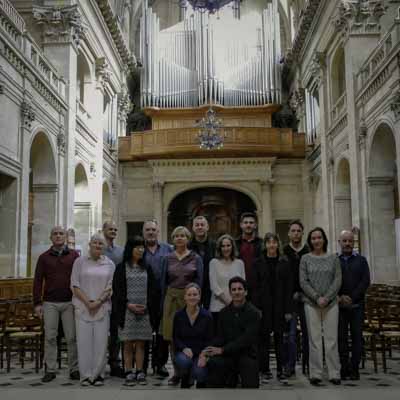


The key lay in reinvigorating the teaching. Gurdjieff groups have often restricted themselves to Gurdjieff’s literature and movements, trying to keep close to his legacy. This approach can also lead to a cumbersome conservatism. To circumvent this, we had to find a fresh way to approach Gurdjieff’s ideas, and we chose to do so by exploring their origin. Each online event aimed to cover one of his main ideas, while inviting the group to study its origin in ancient texts and imagery. This introduced the necessary element of discovery, so missing in a more conservative approach. Furthermore, we incorporated an annual curriculum called The Old New Method, that complemented the intangible digital medium with the tangible imagery of farming. Every month was characterized by a symbolic farming labor, setting the tone for the group’s work during that month.
The initial online results were promising and members soon expressed their desire to meet in person. We started gathering twice a year in destinations of relevance to our teaching: Italy, Israel, Egypt, France, SouthEast Asia, etc. These destinations offered students first-hand experience with traces of past schools, as well as beginning what would become deep personal connections among them. Ultimately, the Fourth Way occurs in life, which means Gurdjieff groups cannot afford to be monastic. After spending a rich week together, it makes perfect sense that each member returns to the circumstances of his or her life, and braves the challenge of applying what they have learned, in their everyday environment.
[RODNEY COLLIN] “[Gurdjieff group work] does not mean that you have to see the other members of your group every day, or even live within a thousand miles of them. It means you must be innerly and organically connected with them and with the force which directs them. It is true that you may have for a while to work very intimately and physically with them, in order that this inner connection should grow strong. But when it is established, your duties may take you somewhere quite different without its being in any way weakened.” iv

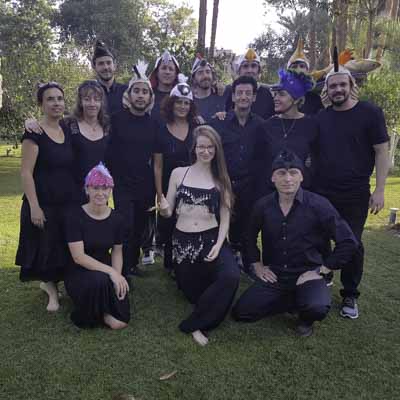


Second line of Work in Gurdjieff Groups
The Benefit of Collective Experience
[GURDJIEFF] The exchange of observations is one of the purposes of the group’s existence. ii
Each member of a Gurdjieff group naturally finds themself in different life circumstances, and these form the backdrop for their inner work. One person may be raising a family, another immersed in career challenges, and a third nursing a relative. These different challenges place different pressures on each group member’s inner work, and, in turn, yield different understandings. In sharing their observations together, each group member benefits from the collective experience. Life is too short for us to experience everything. Group work resolves this impossibility by exposing us to the collective experience. In effect, through such exposure, Gurdjieff groups accelerate their member’s development.
Initially, we tend to consider our strengths and weaknesses as quite unique. The exchange of observations in group work reveals this as an illusion. We hear one member reporting laziness, another their inability to stop moving, a third dreading to speak in public, and a fourth unable to resist unnecessary talk. We realize that what we observe in ourselves exists to a larger or lesser degree in everyone around us. We begin to understand that our weaknesses and strengths are not something to be ashamed or proud of. This lays the ground for dis-identifying with them.
[COLLIN] Everyone needs companions. Whether he joins some formal group of those who knew Ouspensky or Gurdjieff or Nicoll is a different question. But the company of those who are struggling to travel by the same path, he does need. For these truths are too hard for a single man alone to crack. He has to find others with whom he can exchange experience and understanding, share experiments. iv
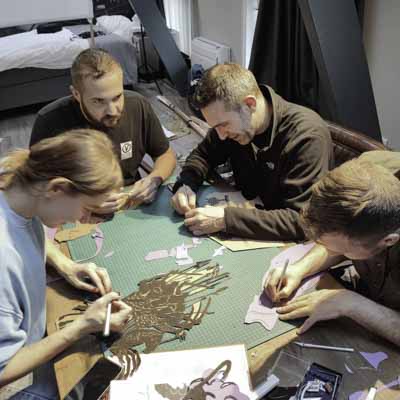

Harmony and Disharmony in Group Work
Gurdjieff spoke of fundamental planetary types that govern every person’s psychology. One person is Mercurial, another Lunar, a third Saturnine, and so forth. These essence-types, and their corresponding chief features, run so deep in our psychology, they invariably lead us to interpret inner work through a subjective lens. The mercurial type interprets the work to mean never being caught asleep; the Lunar interprets it as resisting mechanicality; the Saturnine interprets it as dominating one’s habits. These interpretations are so subtle that we do not even realize we are making them. We assume, in our blindness, that our interpretation is shared by everyone else, until we become exposed to group work. “In a well-selected group, it is exactly the variety of types and the necessity of including and reconciling all their particular points of view that opens the way to new horizons,” said Rodney Colliniv .
In this respect, a group’s disagreements are as beneficial as its harmonious and constructive interactions. When two members of a group disagree, it is always a clash of different subjective points of view; two features battling each other. Such misunderstandings are the norm in everyday life, which earns it the title ‘circle of the confusion of tongues.’ In a Gurdjieff group, members have the possibility of rising beyond these disagreements, since they are aware of their own subjectivity. In such an environment, understanding is not a matter of one feature overpowering another, but of one member understanding the possibility that another looks at things from a different and equally subjective point of view.
Caught in my own error, I find it impossible to entertain a different point of view, especially if I feel I see my neighbor’s error. Once I entertain the possibility that it is not a matter of right and wrong, but of two differing points of view, I not only begin to understand my neighbor, but also begin to see myself objectively—which is the fundamental aim of Gurdjieff groups.
[GURDJIEFF] Other members of the group serve him as mirrors in which he sees himself. But, of course, in order to see himself in other people’s faults and not merely to see the faults of others, a man must be very much on his guard against and be very sincere with himself. ii
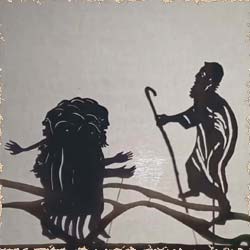


Group Responsibility
[GURDJIEFF] In a group all are responsible for one another… The success of one is the success of all. The failure of one is the failure of all. ii
Self-development follows a pattern wherein efforts that open the door to one level keep the door closed to the next. At the beginning of our work (and for quite a long time), despite being members of a group, we must be fully preoccupied with our own progress. We must keep acquiring new knowledge, keep striving to understand, keep observing ourselves, and keep trying to introduce self-remembering to the various areas of our day. Only this persistence creates the inner intensity needed for progressing in the work.
However, gradually, this preoccupation with our inner work turns against itself. It becomes another dimension of our preoccupation with ourselves–that very ‘self’ we were hoping to break free from when we were first drawn to inner work. We find ourselves in the impossible position of needing to jump over our own knees. This marks a distinct interval in our first line of work, because the more efforts we make in this direction, the more we deepen the problem.
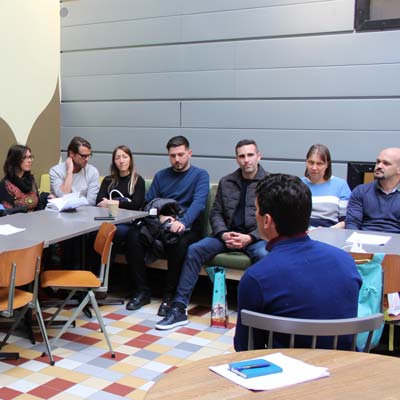
Group work plays an instrumental role in this interval. We are drawn to help others as the only way to harness our gains in the work to something unselfish. But the desire to help can only genuinely come at this interval, not before. And when it does genuinely appear, we are drawn to help other group members as enthusiastically as we had originally been drawn to help ourselves.
[COLLIN] Group work is only possible if a smaller group within it takes more responsibility, works harder, demands more of themselves than the rest. This smaller group in turn is only possible if one or two take more responsibility still, push further towards the goal, press harder on the heels of their teacher and so lead the way. iv
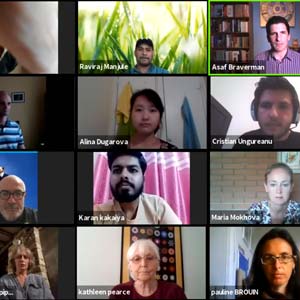
Third Line of Work in Gurdjieff Groups
Part V of the documentary Seeker of Truth reviews how the fourth way differs from the three traditional ways. Groups of the type Gurdjieff gathered in the late 1800’s and the first half of the 1900’s never functioned exclusively for the education of their members. They always harnessed their efforts towards an external undertaking. Once this undertaking had been attained, or if the effort failed, Gurdjieff disbanded his groups. Such external tasks were always a hallmark of fourth way groups, inherent in their proper functioning.
If each group member’s personal efforts form their first line of work, and their interactions with other members form the second line, then the group’s external undertaking opens the possibility of a third line. Group members will naturally differ in their relation to this external task. Those new to the group will have a theoretical understanding of the task (if they understand it at all), while more experienced members might form a more personal relation to it. Second line of work is instrumental in bridging intervals in the first line. Similarly, working together to fulfill the group’s task forces each of its members to reconcile their differences—or in other words, to bridge intervals in their second line of work—through connecting with the group’s higher aim.
[GURDJIEFF] Groups must be connected with some aim of which those who are beginning work in them have no idea whatever and which cannot even be explained to them until they understand the essence and the principles of the work and the ideas connected with it. But this aim towards which without knowing it they are going, and which they are serving, is the necessary balancing principle in their own work. Their first task is to understand this aim, that is, the aim of the teacher. When they have understood this aim, although at first not fully, their own work becomes more conscious and consequently can give better results. ii


Gurdjieff’s own Groups
[BENNETT] Gurdjieff certainly employed the group as a teaching technique… [He] made the notion of the group quite central… He spoke of three lines of work—work for oneself, work for the group, and work for the teacher, or work for the Work. Gurdjieff constantly used substantially the same group methods. v

Seekers of Truth
Gurdjieff’s first group is the Seekers of Truth. Established in the late 1800s, the group by some accounts comprises only three members and by other accounts numbers up to twenty. Gurdjieff’s Seekers share the aim of recovering lost knowledge. Members periodically meet and then disperse, each going his or her own way in search of specific ancient teachings. Their expeditions range from the Middle East, through Central Asia, to the Far East.
An endeavor of this magnitude would have had to have been coordinated by someone playing the role of organizer or teacher, although we are never explicitly told who that person is. Given that the Seekers’ aim is not merely academic, and that they are seeking knowledge that can lead to genuine inner change, we can see how the three lines of work mentioned above apply to their efforts. The task of finding Truth would have served as their third line, their discussions and comparisons of their findings, the second line, and each member’s individual efforts to apply the teachings they found, their first line of work.
We do not know what causes the Seekers of Truth to disband. Perhaps their task of gathering Truth is complete. Perhaps they are forced to disband for other reasons. Either way, by the early 1900’s, Gurdjieff effectively concludes his period of seeking and begins teaching. According to his autobiographical accounts, his first attempts are experimental, with little expectation of results. He studies the dynamics of group work, and is yet to find a permanent location in which to establish regular groups.
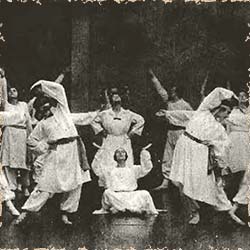
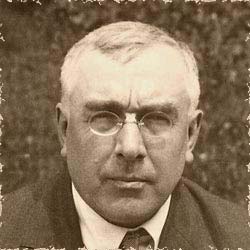

First Russian Groups
Gurdjieff eventually chooses Russia for its peace and prosperity. He arrives in Moscow in 1912 and begins gathering what will become his first long-term students. He teaches mostly in the form of lectures in cafes, but makes consistent efforts towards establishing something more formal and permanent. We have personal accounts from this period by Ouspensky and the De Hartmanns, who cite their efforts to apply Gurdjieff’s teaching, as well as the many discussions that naturally develop between members. In this way, Gurdjieff’s groups incorporate the first and second lines of work.
At this stage, the third line of work mainly consists in helping Gurdjieff establish his groups: disseminating the teaching and introducing it to potential new members. It is noteworthy that this early stage of Gurdjieff’s teaching is also the one in which the most theoretical knowledge is shared. The lectures that form Ouspensky’s book In Search of the Miraculous take place around this time and will remain the most comprehensive presentation of Gurdjieff’s teaching, even though Gurdjieff continues to teach for another 30 years.
Institute for the Harmonious Development of Man
World War I, followed by the Russian Revolution and civil war, cut short Russia’s period of peace and prosperity, thwarting Gurdjieff’s efforts to formalize his groups. In 1919, he attempts to found something more official in Tiflis, Georgia, under the title of The Institute for the Harmonious Development of Man. By this time, he has met the De Salzmanns, whose experience enables him to incorporate movements into his teaching and give public demonstrations. Political instability continues, forcing Gurdjieff and his pupils to move several times. They finally settle in France, where in 1922 he establishes the Chateau Prieuré.
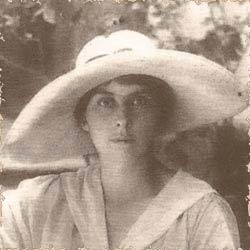
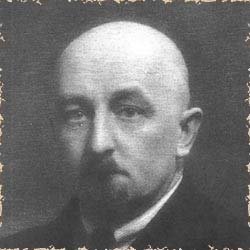
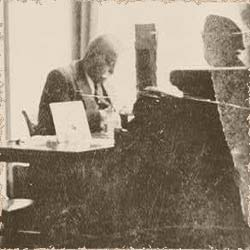

Gurdjieff Groups in France
The form of Gurdjieff’s teaching changes with the acquisition of the Chateau Prieuré at Fontainebleu-Avon. The responsibility for financing and maintaining an estate impacts the nature of his group work. The Chateau is in disrepair. Its restoration becomes the vehicle for Gurdjieff’s teaching and his students’ efforts. He gives occasional talks, and certainly explains many things to individual students, but not on a regular basis. Days and weeks pass while students focus on the routine demands of cooking, cleaning, gardening, reconstructing, and repairing. It is a period of learning through daily physical labor alongside other students, rather than intellectual discussion.
One non-functional element that Gurdjieff maintains throughout this period is his development of the Movements and accompanying music. Every evening, after a long day’s work, students gather to learn and practice the dances. This balances the functional nature of the daily activities with creativity, and also serves a larger-scale aim. Gurdjieff hopes to bring his group to the point where they can perform public demonstrations of the Movements at a professional level. This will become his main means of outreach to potential group members in the years to come, in particular, when he sets out to introduce his teaching to America.
Groups in the Latter Part of Gurdjieff’s Life
On returning from his first visit to America, Gurdjieff has a near-fatal car accident that leaves him seriously injured. A long period of convalescence follows. This will impact the form of his group work. Once he regains consciousness, he releases most of his students, closes the Chateau, and concentrates on writing. From then on, Gurdjieff seems to abandon the idea of establishing a permanent physical home for group work. He will nevertheless continue working with various groups throughout the rest of his life. In the following two decades, he will form and disband groups as the need or opportunity arises. For example, in the 1940s, the form changes to meet the circumstances of wartime and post-war Paris. Gurdjieff’s holds teaching dinners at his small apartment on the rue des Colonels Renard that will eventually draw former and new students, especially from England and America. He will never again lead organized group work in a setting on the scale of the Chateau.
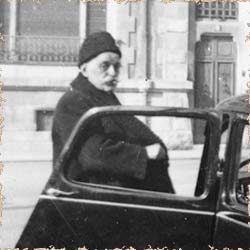
Gurdjieff Groups as Blueprints for the Fourth Way in Modern Times
The character of Gurdjieff’s groups varied greatly throughout his career. Some sought knowledge, others built and maintained permanent residences for groups of students, while others performed the Movements in public or focused on translating and publishing his writings. What qualified as a Gurdjieff group was not its form, but its inner spirit, and that it offered its members the possibility of engaging in three lines of work. Once that spirit diminished, the current form was abandoned and new forms emerged. This accounts for the temporary existence and changing nature of Gurdjieff’s groups.
[COLLIN] It often seemed to me that all Gurdjieff’s ideas about groups recorded in In Search of the Miraculous was not so much practical direction to his followers as the general blueprint for esoteric work in the age to come. iv


.
Frequently Asked Questions
What exactly is a Gurdjieff group?
A typical Gurdjieff group focuses on:
– Self-observation and self-remembering
– Practical tasks that challenge mechanical habits
– Group work as a mirror for seeing one’s own inner contradictions
A lone individual cannot put themselves under the necessary pressure required to progress in this work. Moreover, alone, they cannot tell when they deceive themselves. Working with other people guarantees social pressure indispensable for this work. In group conditions, even if an individual deceives themselves, the rest of the group will not flow along with their deceit and will be able in due time to point it out to the individual.
Are Gurdjieff groups considered cults?
– Gurdjieff explicitly discouraged blind faith and emphasized critical thinking, telling students to verify everything through their own experience rather than accepting teachings on authority.
– The Fourth Way places strong emphasis on personal responsibility and inner struggle rather than dependency on a teacher or group.
– Genuine Gurdjieff groups do not isolate members from society but instead encourage them to practice the work principles while fully engaged in ordinary life.
– Gurdjieff himself stated: “There is no outward initiation… No system or school whatsoever can do for a man the work that he must do himself.”
– The work focuses on developing self-awareness and consciousness rather than unconditional acceptance of dogma.
Based on these criteria, if a group exhibits cult-like characteristics of control, isolation, or unquestioning obedience, it has departed from fundamental Fourth Way principles and cannot be considered an authentic Gurdjieff group.
How can I find a legitimate Gurdjieff group near me?
-Begin your search online for “Gurdjieff Group” or “Fourth Way Group”. Many groups have online presences which can offer the newcomer a useful insight into the nature of their work and methods. If you form a good impression of the group, consider traveling to visit its members in person.
– Upon finding a group that interests you, contact them, share a bit about yourself, and inquire about their teaching methods, meeting structure, and practical approach to the Work.
– Ask to attend a meeting before making a commitment. Legitimate groups often emphasize practical self-observation, conscious labor, and intentional suffering rather than theoretical discussions alone.
The most important indication of a group’s legitimacy should be your own impression and experience. Look for groups that encourage questioning, personal verification, and application of the Work in everyday life. Common red flags to watch for include:
– A charismatic leader claiming exclusive authority
– Pressure to isolate from family, friends, or outside interests
– Financial exploitation or excessive mandatory payments
– Emphasis on the teacher’s personality rather than the Work itself
While some established organizations maintain valuable connections to Gurdjieff’s original teaching, it’s worth remembering that Gurdjieff himself said, “The fourth way has no definite forms… it is never a permanent way… and there are no institutions connected with it. It appears and disappears governed by some particular laws of its own.” Gurdjieff himself drew from diverse sources rather than a single lineage, as described in his book Meetings with Remarkable Men.
A century has elapsed since Gurdjieff actively taught, and the forms and institutions connected with the spirit of the Fourth Way have naturally evolved. What matters most is finding a group that supports genuine inner work and self-development according to Fourth Way principles, regardless of its institutional history.
What typically happens in a Gurdjieff group meeting?
– Self-observation reports – Members share personal observations made during the week about their mechanical behaviors, emotional reactions, or moments of self-remembering, often focusing on a specific aspect of inner work.
– Readings and discussion – Groups frequently study passages from key Fourth Way texts such as Beelzebub’s Tales to His Grandson, In Search of the Miraculous, or Views from the Real World, exploring their practical application.
– Practical exercises – This may include group attention exercises, self-remembering practices, divided attention work, or specific psychological tasks designed to confront habitual patterns.
– Task assignments – Members may receive individual or group tasks to practice between meetings, with subsequent sharing of insights and difficulties encountered.
As Gurdjieff himself noted, “There are only special schools; there are no general schools. Every teacher, or guru, is a specialist in some one thing. One is an astronomer, another a sculptor, a third a musician. And all the pupils of each teacher must first of all study the subject in which he has specialized.”
This principle explains the diversity among Gurdjieff groups today. While Gurdjieff’s own specialty included the sacred dances, this doesn’t mean all legitimate groups must practice them. Each group tends to reflect the focus and expertise of its particular teacher. The essential elements remain consistent—developing self-observation, self-remembering, and working against mechanical patterns—but the specific methods and emphases will vary. When considering a group, determine whether its particular approach resonates with your own needs and interests in the Work.
Sources
- Views from the Real World by George Ivanovich Gurdjieff
- In Search of the Miraculous by Peter Demianovich Ouspensky
- The Fourth Way by Peter Demianovich Ouspensky
- The Theory of Conscious Harmony by Rodney Collin Smith
- Gurdjieff: Making a New World by John Godolphin Bennett

In 2022/4, BePeriod will be creating a full-length documentary on George Gurdjieff

